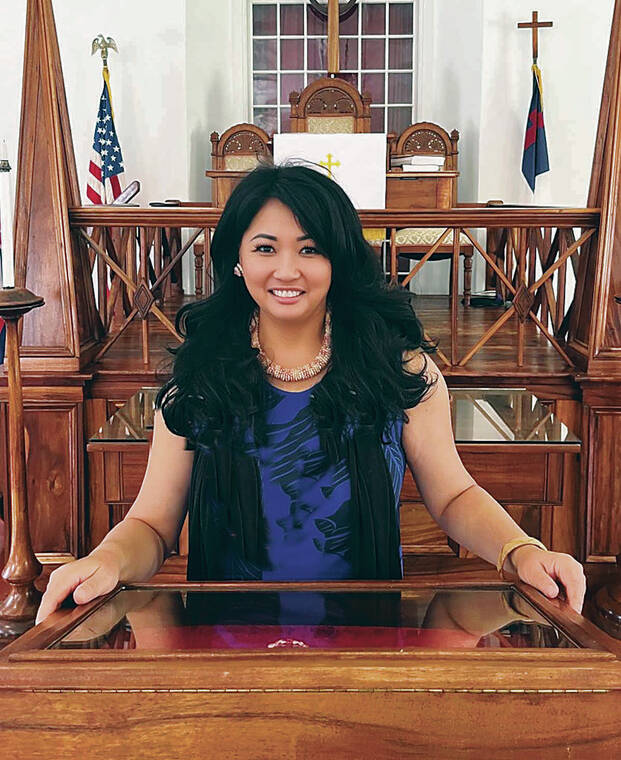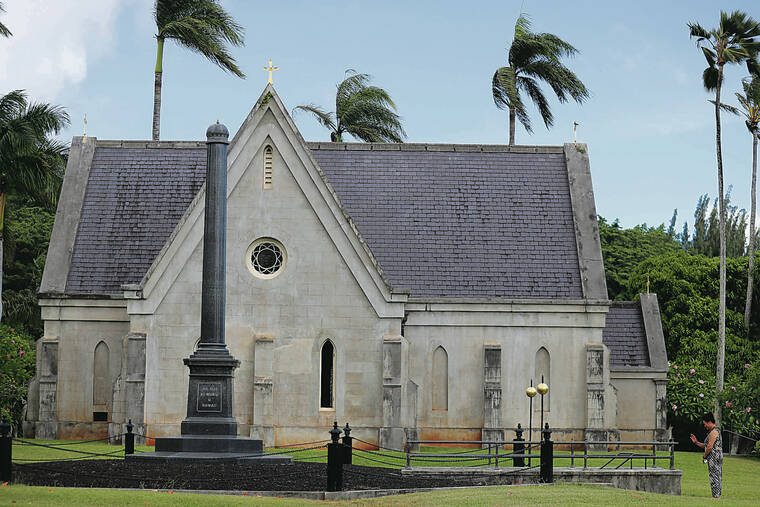Backlash surrounding new Royal Mausoleum curator continues

COURTESY DLNR
Doni Chong:
She is the current curator at the mausoleum

JAMM AQUINO / JAQUINO@STARADVERTISER.COM
Recent backlash has occurred regarding the historic park’s curator hiring process not being directly related to the lineal kahu, or caretakers, of the Royal Mausoleum State Monument, at top.

JAMM AQUINO / JAQUINO@STARADVERTISER.COM
Above, memorial headstones of Hawaiian royalty are on the mausoleum’s grounds.

JAMM AQUINO / JAQUINO@STARADVERTISER.COM
The Royal Mausoleum was built in 1865 for Hawaiian royalty.




Frustration surrounding the hiring process for the curator of the Royal Mausoleum State Monument at Mauna Ala continues, even after the state announced the creation of a second, “culturally focused” position earlier this month.
The state Department of Land and Natural Resources announced the new position June 4. The hiree will work with current curator Doni Chong, following feedback from the Native Hawaiian community that questioned Chong’s appointment due to her lack of familial ties to or training from previous caretakers.
“After listening to many of our kupuna, especially leaders of Native Hawaiian organizations, it became clear to me that Mauna Ala needs an additional person to focus solely on cultural protocols and practices, and to do outreach and communications with the Native Hawaiian community,” Gov. Josh Green said in a DLNR news release.
Mauna Ala has served as the resting place of Hawaiian royalty, including members of the Kamehameha and Kalakaua dynasties, since 1865.
According to the news release, the duties of the culturally centered second position “will be more fully developed after meetings and discussions with Native Hawaiian leaders.”
“We will seek input from the broader Hawaiian community, cultural practitioners, the Office of Hawaiian Affairs, Ali‘i Trusts and ohana with connections to Mauna Ala in developing the specific duties of this new position,” DLNR Chair Dawn Chang said in the release.
Don't miss out on what's happening!
Stay in touch with breaking news, as it happens, conveniently in your email inbox. It's FREE!
But in a statement in response to the announcement, the Descendants of Ho‘olulu, who have served as caretakers, or kahu, for Mauna Ala for over 100 years, said they were never consulted about this solution.
“I think that it’s positive that the governor and the DLNR recognize that a culturally appropriate position, which really should be a proper kahu, that they’re recognizing the need for that,” James Maioho, the lineal kahu and one of the four finalists who was being considered for the curator role, told the Honolulu Star- Advertiser. “I think it’s a step in the right direction.”
But in the statement, Maioho wrote that the “culturally focused” second position is not a full solution, as it does not guarantee a kahu of the lineal family to look after the site.
“The DLNR does not have the authority or even the moral high ground to make a cultural, spiritual decision about anything regarding Mauna Ala and the protection of our kupuna. The spiritual authority rests with the Kahu,” Maioho wrote. “Nothing short of a full reversal and restoration of the lineal Kahu, residing on site, is pono or acceptable.”
The creation of the second position comes amid backlash from members of the Native Hawaiian community following Chong’s appointment to the curator role.
Chong was announced in mid-May as the 18th curator for Mauna Ala. According to the DLNR news release where she was announced, Chong was selected after two rounds of interviews with selected applicants and after the selection committee “went to Mauna Ala and walked the grounds seeking guidance prior to making its decision.”
“It was Doni’s balance of experiences, perspectives and cultural connections to Mauna Ala, as well as her keen understanding of the unique and varied role of the curator position that set her apart,” Chang said in the release. “Doni radiated genuine humility and gratitude for the opportunity to serve and care for the Alii, and she visited Mauna Ala to pule with her ohana before accepting the position.”
But Chong is not a direct lineal descendant of any of the three families who have served as kahu at Mauna Ala since the mid-1800s, nor has she received any sort of training from a kahu.
A direct descendant of High Chief Ho‘olulu and Ho‘olulu’s eldest child, High Chief Kaihe‘ekai, Maioho wrote that the caretaker responsibilities have been passed to him over generations. He worked as an unpaid volunteer and caretaker at Mauna Ala since the curator role was vacated on May 1, 2023, by his first cousin William “Kai” Bishop Kaihe‘ekai Maioho, who appointed Maioho as his successor.
“This decision is not pono with our ways and has ignored the input of the Kanaka community. It has ignored the recommendations of the Royal Societies, the Civic Clubs, the other two acknowledged remaining royal families and hundreds of supporters, Halaus, and schools,” Maioho wrote on Chong’s appointment. “It has completely disregarded the practice of familial appointment and the genealogies pertinent to this sacred role.”
Maioho said that there is a “synergistic relationship” that develops among the family, the kahu and the kupuna.
“We’ve all been taught, since we were kids, as was my father, as was my grandmother, as was her parents, all the way down the line, how to look after and commune with our kupuna,” he said. “We recognize them, and so over generations, this bond has been built and deepened and strengthened, and that’ll always continue. By putting somebody else in there, it disrupts the basis of our whole spiritual system.”
Chong’s scheduled media availability in her new role on May 14 was postponed a day for a meeting with “leaders from various Hawaiian organizations who have connections to Mauna Ala.”
Native Hawaiian stakeholders also held an information briefing on cultural protocol at the state Capitol in late May, calling out DLNR for excluding those with lineal connections in the hiring process — whose input they said was traditionally included in hiring discussions.
“DLNR and its chair have disregarded our cultural mores and traditions,” OHA Board of Trustees Chair Carmen Hulu Lindsey said at the briefing. “Ignoring this tradition in favor of a closed-door hiring process disrespects our heritage and our kupuna, our ancestors.”
Lindsey said that when OHA asked for consultation with Chang about the curator’s hiring process, Chang said the process was solely an administrative matter. Representatives from two of the Hawaiian Royal Benevolent Societies present at the briefing said they also received similar responses.
Chang said the hiring process used to fill the curator position was the same as the process used to fill the position in the past, and that when OHA and the Royal Benevolent Societies had reached out to her, the hiring process already was underway.
DLNR said there are no plans to rescind Chong’s appointment at this time.
As plans for the new position begin to take place, Maioho said the family’s main position is the need for a kahu in residence at Mauna Ala — something that’s “still undefined between these two jobs.”
Currently, no kahu resides at Mauna Ala, as the house was stripped last spring after the previous curator vacated the role for a planned renovation — a renovation that was pushed back months after the August wildfires on Maui. Throughout the period in which Maioho was serving as a volunteer caretaker, he said he visited the site only during the day, despite the kupuna being more active at night.
“We have to remember our kupuna first,” Maioho said, “and then, everything that goes into managing the place.”
Maioho said the house will “probably not be livable” until November.
DLNR said a timeline for recruitment efforts for the culturally focused position has not yet been decided. No further information on the new position’s responsibilities, or on the qualifications necessary to fill the position, have been made available.
“Creating a whole new position is complicated and it may be a very lengthy process,” Maioho said. “We’ll try to do our best to work with whatever we have going forward and make sure that the kupuna are cared for properly, and that means being spiritually and physically guarded around the clock.”
———
Former Star-Advertiser reporter Linsey Dower contributed to this story.




